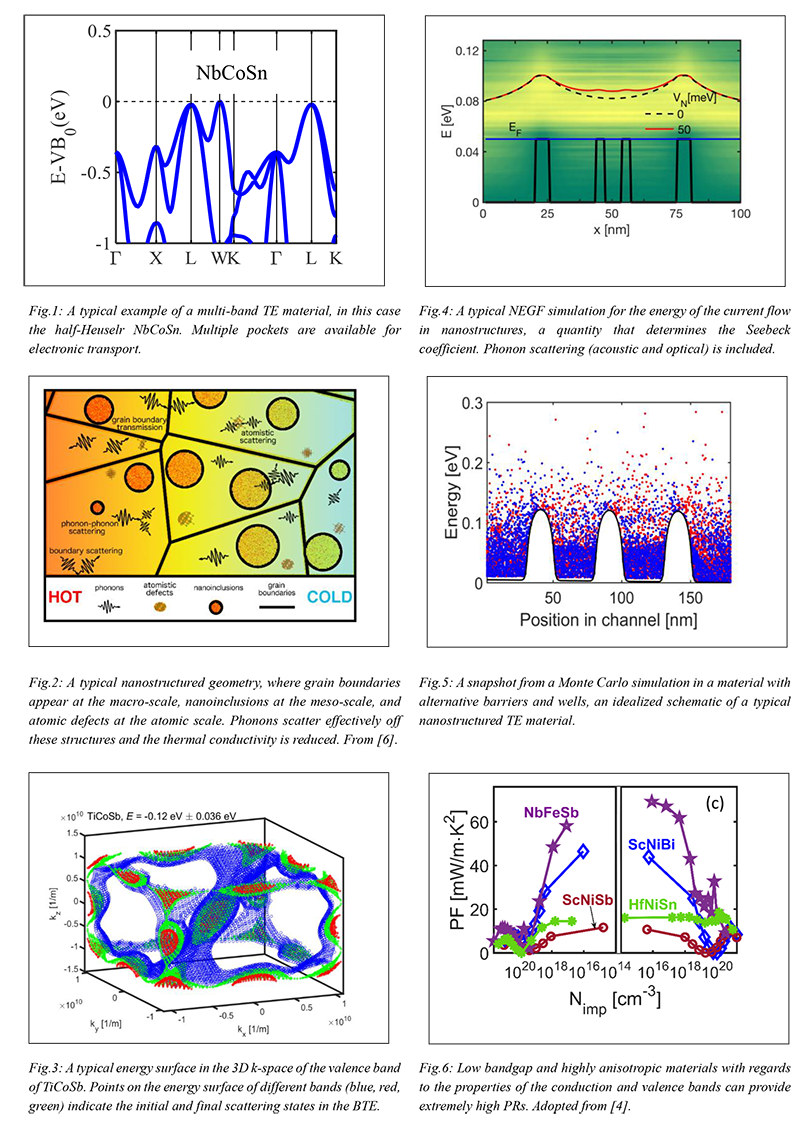IWCN 2021: Thermoelectric Properties of Complex Band and Nanostructured Materials
Category
Published on
Abstract
Thermoelectric (TE) materials convert heat from temperature gradients into useful electrical power. Over the last two decades, an enormous progress has been achieved, owning to the synthesis of complex bandstructure materials and their alloys (Fig. 1), and nanostructured materials (Fig. 2) [1]. The figure of merit, ZT=σS2T/κ where σS2 is the power factor (PF) and κ the thermal conductivity, quantifies the efficiency. It has increased by 2-fold, to values above ZT > 2 across materials and operating conditions, with a maximum of ZT=2.6.
In this work, we describe a computational framework to compute the electronic and thermoelectric transport in materials with multi-band electronic structures of an arbitrary shape (Fig. 3) by coupling density function theory (DFT) bandstructures to the Boltzmann Transport Equation (BTE). We explain the computational complexities and the approximations made. We then show how ‘real-space’ methods, such as the non-equilibrium Green’s function (Fig. 4) and the Monte Carlo methods (Fig. 5) can be used to design nanostructured materials with very high TE PFs. We elaborate on the computational framework needed to advance the field of TEs.
Here, we present four related studies. First: due to the complexity of the electronic structure, it is customary to use a constant value for the relaxation times within the BTE. We show that the full energy and momentum dependence of the relaxation times is essential in capturing the correct transport features [2]. Second: in order to identify high performance materials within the myriad of possibilities, we present the development of a set of descriptors that can be used in materials screening studies [3]. A combination of the number of valleys, dielectric constant, conductivity effective mass, deformation potential, and bandgap, forms a useful descriptor. Third: we present a study in which we show a possible route to achieve over an order of magnitude increase in the TE power factor, by utilizing narrow gap materials and bipolar transport, a regime which is usually avoided [4]. Four: We demonstrate a practical nanostructuring design which can also allow for 10-fold improvement in the PF [5, 6].

Credits
Neophytos Neophytou1, Patrizio Graziosi2, Zhen Li1, Vassilios Vargiamidis1 1 School of Engineering, University of Warwick 2 CNR—ISMN, v. Gobetti 101, 40129, Bologna, Italy n.neophytou@warwick.ac.uk
Sponsored by
References
- [1] D. Beretta et al., Materials Science and Engineering: R: Reports, 138, 210–255, (2019).
- P. Graziosi, Journal of Applied Physics 126, 155701 (2019).
- P. Graziosi, ACS Appl. Energy Mater., 3, 6, 5913–5926, (2020).
- P. Graziosi, Journal of Physical Chemistry C, 124, 34, 18462–18473, (2020).
- N Neophytou et al., European Physical Journal B, 93, 213, (2020).
- N. Neophytou et al., MaterialsToday Physics, 11, 100159, (2019).
Cite this work
Researchers should cite this work as follows: